Hyposmotic - Study guides, Class notes & Summaries
Looking for the best study guides, study notes and summaries about Hyposmotic? On this page you'll find 11 study documents about Hyposmotic.
All 11 results
Sort by
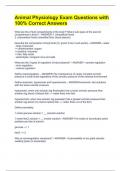
-
Animal Physiology Exam Questions with 100% Correct Answers
- Exam (elaborations) • 26 pages • 2024
- Available in package deal
-
- $16.49
- + learn more
What are the 2 fluid compartments of the body? What 2 sub-types of the second compartment is there? - ANSWER-1. intracellular fluids 2. extracellular fluids (interstitial fluid, blood plasma) Describe the composition of body fluid (3). (point 2 has 3 sub-points) - ANSWER-- water - large molecules -> carbohydrates: sugars -> proteins: enzymes -> fats: fatty acids - electrolytes: inorganic ions and salts What are the 3 types of regulation of blood plasma? - ANSWER-- osmotic re...
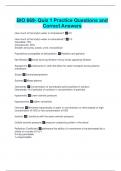
-
BIO 669- Quiz 1 Practice Questions and Correct Answers
- Exam (elaborations) • 12 pages • 2024
- Available in package deal
-
- $9.99
- + learn more
How much of the body's water is intracellular? 2/3 How much of the body's water is extracellular? 1/3 Interstitial: 75% Intravascular: 25% Smaller amountsL sweat, urine, transcellular Populations susceptible to dehydration: Pediatric and geriatric Net filtration forces favoring filtration minus forces opposing filtration Aquaporins small pores in cells that allow for water transport across plasma membrane Solute Electrolytes/proteins Solvent Water/plasms Osmolarity Concentration of osmo...
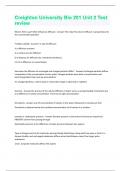
-
Creighton University Bio 201 Unit 2 Test review Questions With 100% Correct Answers.
- Exam (elaborations) • 10 pages • 2024
- Available in package deal
-
- $9.69
- + learn more
What is Fick's Law? What influences diffusion - Answer-The molar flux due to diffusion is proportional to the concentration gradient F=kA((c1-c2)/d)) - Answer-F is rate of diffusion K is diffusion constant A is surface area for diffusion D id distance for diffusion (ex: membrane thickness) C1-C2 is difference in concentration How does the diffusion of uncharged and charged particles differ? - Answer-Uncharged particles diffuse irrespective of the concentration of each other. Charged par...

-
Chapter 5 Integumentary System Latest Update 100% Pass
- Exam (elaborations) • 5 pages • 2024
- Available in package deal
-
- $8.99
- + learn more
Chapter 5 Integumentary System Latest Update 100% Pass The integumentary system consists of... skin, hair, glands, and nails Functions of the integumentary system include: protection, sensation, temperature regulation, vitamin D production, and excretion epidermis stratified squamous epithelium divided into five strata five strata of epidermis include: stratum basale, stratum spinosum, stratum granulosum, stratum lucidum, stratum corneum stratum basale Bottom layer of the epidermis. cuboida...

-
Understanding Patho: Quiz 1 - Electrolytes & Immunity - Exam 1 Questions With Verified Answers
- Exam (elaborations) • 44 pages • 2024
-
- $13.49
- + learn more
Understanding Patho: Quiz 1 - Electrolytes & Immunity - Exam 1 Questions With Verified Answers What makes up approximately _______ percent of lean body weight in men? women? - answermen = 60%. women = 50%. what fraction of water is in the intracellular space? extracellular space? - answerintracellular = two-thirds. extracellular = one-third. Is the ICF or ECF subdivided into more categories? what are these? - answerECF. Into intravascular and interstitial. What percentage of the ECF ...
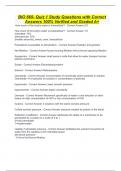
-
BIO 669- Quiz 1 Study Questions with Correct Answers 100% Verified and Graded A+
- Exam (elaborations) • 12 pages • 2024
- Available in package deal
-
- $9.79
- + learn more
BIO 669- Quiz 1 Study Questions with Correct Answers 100% Verified and Graded A+ How much of the body's water is intracellular? - Correct Answer 2/3 How much of the body's water is extracellular? - Correct Answer 1/3 Interstitial: 75% Intravascular: 25% Smaller amountsL sweat, urine, transcellular Populations susceptible to dehydration: - Correct Answer Pediatric and geriatric Net filtration - Correct Answer forces favoring filtration minus forces opposing filtration Aquaporin...

-
BIO 320 EXAM 2 STUDY GUIDE SOLUTIONS
- Exam (elaborations) • 12 pages • 2024
-
- $10.49
- + learn more
BIO 320 EXAM 2 STUDY GUIDE SOLUTIONS Describe all processes by which organisms exchange heat with their environment. - ANSWER- Radiation, Conduction, Convection, Evaporation Radiation - ANSWER-*Emission of electromagnetic energy by surface (i.e. sun) *When objects are warmed by radiation, they emit lower-energy radiation as infrared light *The temp of the radiating surface determines how rapidly an object loses energy by radiation to colder parts of the environment. Conduction - ANSWER-*...
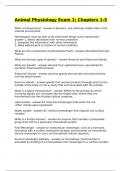
-
Animal Physiology Exam 1: Chapters 1-5
- Exam (elaborations) • 11 pages • 2024
-
- $10.99
- + learn more
What are the components of extracellular fluid? - answer-Interstitial fluid and Plasma What are the two types of glands? - answer-Exocrine and Endocrine Glands What are glands? - answer-derived from epithelial tissue, specialized for secretion (chemicals/hormones) Endocrine Glands - answer-ductless glands that secrete hormones directly into the blood stream Exocrine Glands - answer-glands that secrete products through ducts to the outside of the body or into a cavity that communicate...
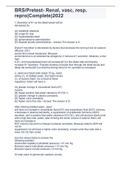
-
BRS/Pretest- Renal, vasc, resp, repro(Complete)2022
- Exam (elaborations) • 27 pages • 2022
-
- $17.99
- + learn more
1. Secretion of K+ by the distal tubule will be decreased by (A) metabolic alkalosis (B) a high-K+ diet (C) hyperaldosteronism (D) spironolactone administration (E) thiazide diuretic administration The answer is D Distal K+secretion is decreased by factors that decrease the driving force for passive diffusion of K+ across the luminal membrane. Because spironolactone is an aldosterone antagonist, it reduces K+ secretion. Alkalosis, a diet high in K+, and hyperaldosteronism all incr...
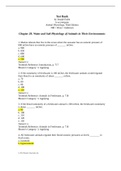
-
Chapter 28: Water and Salt Physiology of Animals in Their Environments Hill • Wyse • Anderson
- Exam (elaborations) • 20 pages • 2022
-
- $9.49
- + learn more
1. Marine teleosts that live in the ocean where the seawater has an osmotic pressure of 800 mOsm have an osmotic pressure of _______ mOsm. a. 900 b. 850 c. 800 d. 600 e. 500 Answer: e Textbook Reference: Introduction, p. 717 Bloom’s Category: 3. Applying 2. If the osmolarity of freshwater is 100 mOsm, the freshwater animals would regulate their blood to an osmolarity of about _______ mOsm. a. 70 b. 80 c. 90 d. 100 e. 120 Answer: e Textbook Reference: Animals in Freshwater, p....

$6.50 for your textbook summary multiplied by 100 fellow students... Do the math: that's a lot of money! Don't be a thief of your own wallet and start uploading yours now. Discover all about earning on Stuvia


